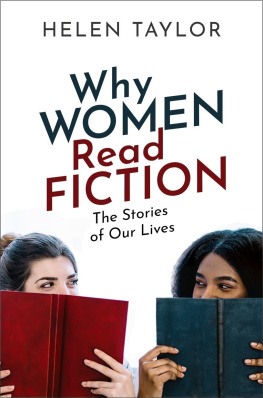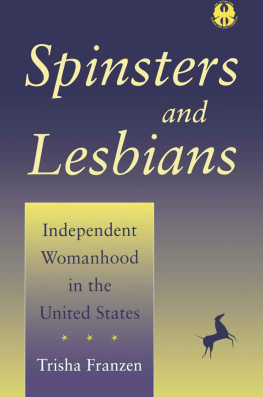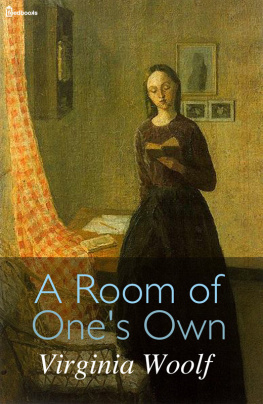Odd women?
Spinsters, lesbians and widows in British womens fiction, 1850s1930s
Emma Liggins
Manchester University Press
Manchester and New York
distributed in the United States exclusively
by Palgrave Macmillan
Copyright Emma Liggins 2014
The right of Emma Liggins to be identified as the author of this work has been asserted by her in accordance with the Copyright, Designs and Patents Act 1988.
Published by Manchester University Press
Oxford Road, Manchester M13 9NR, UK
and Room 400, 175 Fifth Avenue, New York, NY 10010, USA
www.manchesteruniversitypress.co.uk
Distributed in the United States exclusively by
Palgrave Macmillan, 175 Fifth Avenue, New York,
NY 10010, USA
Distributed in Canada exclusively by
UBC Press, University of British Columbia, 2029 West Mall,
Vancouver, BC, Canada V6T 1Z2
British Library Cataloguing-in-Publication Data
A catalogue record for this book is available from the British Library
Library of Congress Cataloging-in-Publication Data applied for
ISBN 978 0 7190 8756 1 hardback
First published 2014
The publisher has no responsibility for the persistence or accuracy of URLs for any external or third-party internet websites referred to in this book, and does not guarantee that any content on such websites is, or will remain, accurate or appropriate.
Typeset 11/13 Bembo Std
by Graphicraft Limited, Hong Kong
I would especially like to thank Margaret Beetham, Ginette Carpenter, Kristin Ewins, Faye Hammill, Antony Rowland and Deborah Wynne for offering invaluable advice and much-needed corrections to draft chapters. Berthold Schoene helpfully commented on the project in its early stages. I have also benefited from the insights of researchers working on the fin de sicle , queer theory and female modernisms, in particular Lorna Shelley, Caroline Baylis-Green, Helen Nicholson, Michael Lee, Kirsty Bunting, Nadine Muller, Emma Sterry, Emma Short, Katherine Cooper and Carolyn Oulton. Feedback from audiences at womens writing conferences, and at the North-West Long Nineteenth-Century Seminar and the Northern Modernism Seminar, has enabled me to refine and develop my ideas, and Im grateful to Katherine Holden and Bill Greenslade for being so enthusiastic and spurring me on when I gave a research seminar at the University of the West of England in 2013.
The completion of the book was made possible by research leave granted by Manchester Metropolitan University. My thanks are also due to my colleagues in the English Department at Manchester Metropolitan University, particularly Sue Zlosnik, Jess Edwards, Linnie Blake and Angelica Michelis, for their generosity and support, when I needed extra time to work on this project, or was struggling with the demands of research and child-care. Special thanks to Adam Rounce, for patiently answering my never-ending queries about how to use a computer. Sarah McCall, Cathy Devine, Elana Jowell, Dawn Cole, Warren Osborne and Claire Wakefield have all been brilliant at entertaining my two girls, Polly and Clara Rowland, whilst I stared at the screen. I am also grateful to Polly and Clara for never pressing Delete when it was their turn on the lap-top.
The editorial team at Manchester University Press have been supportive and professional throughout the process. Staff at Manchester Metropolitan University Library, the John Rylands Library, Manchester Central Library, the British Library and the Womens Library have always been helpful and efficient.
Earlier versions of some of the material in Chapter 2 first appeared in Womens Writing 19:1 (2011) and in Carolyn Oulton and Adrienne Gavin (eds.), Women Writers of the Fin de Sicle: Authors of Change (Palgrave, 2011). The discussion of Evelyn Sharp is also reprinted from Emma Liggins, Andrew Maunder and Ruth Robbins, The British Short Story (Palgrave, 2010). I am grateful to Taylor & Francis and Palgrave for permission to reproduce material.
The girl who doesnt marry is in no way different, physically, mentally, emotionally, from the girl who does marry. The law of numbers is against her, nothing else She has within her all the wholesome instincts of her age and sex. Whether she analyses the situation for herself or not, she wants to fall in love and make a home with a man and have children by him. If she didnt have these instincts, conscious or unconscious, we should draw away from her, instantly, instinctively, as if we were confronted with something abnormal, perverted, unnatural. Yet when, through living in a country where there are more women than men, she becomes odd woman out, what do we expect of her? Nothing less than that she should wipe out of herself all these instincts and wishes and feelings that we so highly approve in her if she marries.
Clemence Dane, The Womens Side (1926)
The woman outside heterosexual marriage in the second half of the nineteenth century, often derided as an abnormality, was variously classified as redundant, superfluous, anomalous, incomplete, odd. Paradoxically, she could also be seen as new, modern, the woman of the future. From the era of the New Woman to the outbreak of the Second World War, she was increasingly seen as a misfit, an outcast, an outsider, a queer presence in a Britain governed by heterosexual norms. The woman without heterosexual desire, or a domestic space shared with a husband and children, was stigmatised as abnormal, perverted, unnatural. Yet the outsider status of lesbians, spinsters and widows could, and often did, allow them to transgress the norms of female behaviour and to stretch the rules governing sexuality which hemmed in conventional wives and mothers. Despite the moral panic about lesbianism, argues Rita Felski, the pathologised lesbian functioned as an exotic, a heroine of the modern, liberated from the straitjacket of marriage. In Virginia Woolfs feminist polemic Three Guineas (1938) outsiders can experiment with new behaviours owing to their comparative freedom from certain inhibitions and persuasions; though she uses the term to encompass the daughters of educated men of the post-war period, it can be applied to unattached middle-class women from the mid-Victorian period onwards.
This study seeks to examine the ways in which the queerness and abnormality of the single woman within British womens writing between the 1850s and the 1930s served to disrupt and denaturalise what Judith Butler has referred to as the regulatory practices of compulsory heterosexuality and gender stability. This time-span facilitates an exploration of the continuities and dialogues between Victorian and modernist texts, tracing the evolution of spinsters, lesbians and widows on either side of key events in twentieth-century history such as the outbreak of the First World War and the obscenity trial of Radclyffe Halls novel in 1928. Associations with lesbians and female communities, and independence from male control, lent spinsters and widows a disruptive queerness, which threatened the compulsory order of sex/gender/desire. These odd women, positioned outside heteronormativity, albeit in different ways, not only challenged ideologies of middle-class femininity and sexuality, but also helped to reinvent them. In novels, stories, autobiographies and feminist polemic, women writers from Charlotte Bront to Virginia Woolf shifted attention away from the conventional wife and mother towards the odd woman, whose eccentricity became a means of testing out new possibilities for female subjectivity. In his reading of nineteenth-century plots, Alex Woloch emphasises the disruptive, oppositional role played by eccentric minor characters, whose narrative subordination, often linked to social subordination, usually means that they are wounded, exiled, expelled, ejected, imprisoned, or killed. Whilst before 1850 spinsters, lesbians and widows were usually minor characters who were expelled, their status within British womens fiction changed in the period under discussion here, so that their eccentricity came to be valued, diffused or integrated into alternative versions of the normal. This process can usefully be mapped onto the history of feminism from the 1850s onwards, in that representations of the odd woman reflected and responded to political campaigning around issues such as higher education, the vote, womens work, contraception and divorce, often exposing the difficulties of implementing feminist change.










